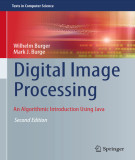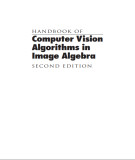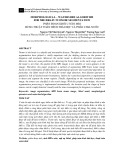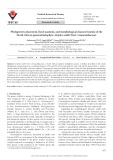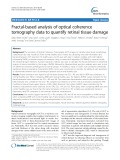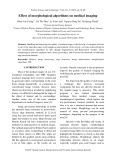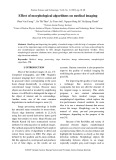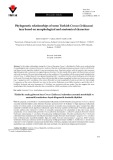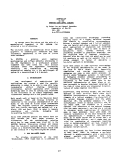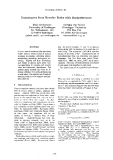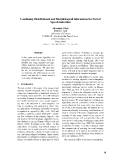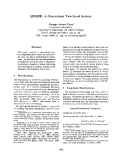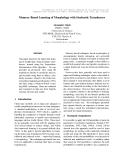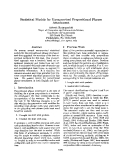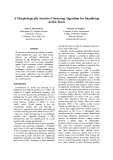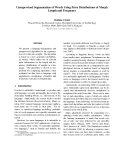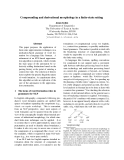
Morphological algorithms
-
Part 1 of ebook "Digital image processing: An algorithmic introduction using Java (Second edition)" provides readers with contents including: Chapter 1 - Digital images; Chapter 2 - ImageJ; Chapter 3 - Histograms and image statistics; Chapter 4 - Point operations; Chapter 5 - Filters; Chapter 6 - Edges and contours; Chapter 7 - Corner detection; Chapter 8 - Finding simple curves, the hough transform; Chapter 9 - Morphological filters;...
 406p
406p  daonhiennhien
daonhiennhien
 03-07-2024
03-07-2024
 1
1
 1
1
 Download
Download
-
Ebook "Handbook of computer vision algorithms in image algebra" includes content: Image algebra, image enhancement techniques, edge detection and boundary finding techniques, thresholding techniques, thinning and skeletonizing, connected component algorithms, morphological transforms and techniques, linear image transforms,.... and other contents.
 425p
425p  haojiubujain07
haojiubujain07
 20-09-2023
20-09-2023
 7
7
 4
4
 Download
Download
-
In particular, the Sobel mask will be used for tumor edge detection, then dilation operator is applied to link all dashed tumor boundaries, before the watershed algorithm is implemented to detect and segment the tumor regions.
 9p
9p  vidoctorstrange
vidoctorstrange
 06-05-2023
06-05-2023
 5
5
 2
2
 Download
Download
-
Atriplex mollis Desf. (Amaranthaceae), a North African endemic halophytic species, is further described in this study. Phylogenetic analysis based on a combined dataset of ITS and ETS rDNA and atpB-rbcL and trnK cpDNA showed that A. mollis is closely related to the Malta- and Gozo-endemic Cremnophyton lanfrancoi Brullo & Pavone. Given this close phylogenetic relationship, A. mollis is also considered among the oldest species of Atriplex, together with C. lanfrancoi. Molecular data also suggest that A. mollis in North Africa, C. lanfrancoi on Malta Island, and Atriplex cana Ledeb.
 12p
12p  tudichquannguyet
tudichquannguyet
 29-11-2021
29-11-2021
 8
8
 2
2
 Download
Download
-
Digital plant images are becoming increasingly important. First, given a large number of images deep learning algorithms can be trained to automatically identify plants. Second, structured image-based observations provide information about plant morphological characteristics. Finally in the course of digitalization, digital plant collections receive more and more interest in schools and universities.
 11p
11p  viwyoming2711
viwyoming2711
 16-12-2020
16-12-2020
 14
14
 0
0
 Download
Download
-
The sensitivity of Optical Coherence Tomography (OCT) images to identify retinal tissue morphology characterized by early neural loss from normal healthy eyes is tested by calculating structural information and fractal dimension.
 10p
10p  vikentucky2711
vikentucky2711
 26-11-2020
26-11-2020
 13
13
 1
1
 Download
Download
-
Handling and improving the quality of medical images with the help of computer software is one of the important stages in the diagnosis and treatment. In this article, we focus on describing the new morphological algorithms by ITK (Insight Segmentation and Registration Toolkit). These morphological operators eliminate noise, detect good edges, and overcome the drawback of traditional edge detection methods.
 52p
52p  elandorr
elandorr
 05-12-2019
05-12-2019
 15
15
 1
1
 Download
Download
-
Handling and improving the quality of medical images with the help of computer software is one of the important stages in the diagnosis and treatment. In this article, we focus on describing the new morphological algorithms by ITK (Insight Segmentation and Registration Toolkit).
 8p
8p  vineptune2711
vineptune2711
 04-11-2019
04-11-2019
 13
13
 1
1
 Download
Download
-
In this study, relationships among the 15 taxa of the genus Crocus L. distributed in Turkey were analysed using 29 morphological and 4 anatomical characters. Analysis of the data set utilising maximum parsimony criterion with Branchand-Bound search algorithm yielded 32 most parsimonious trees. Bootstrap analysis with the majority rule consensus algorithm generated a consensus tree supporting some branches.
 8p
8p  vibasque27
vibasque27
 27-03-2019
27-03-2019
 12
12
 0
0
 Download
Download
-
Finnish by establishing correspondences between a surface alphabet and a lexical alphabet (the two levels) and using a lexicon to determine which combinations of characters and morphemes are legal. Moreover, this is done by means of declarative rules, thereby avoiding the procedural problems of generative phonology, and the algorithm used is language independent.
 7p
7p  buncha_1
buncha_1
 08-05-2013
08-05-2013
 38
38
 1
1
 Download
Download
-
Context sensitive rewrite rules have been widely used in several areas of natural language processing, including syntax, morphology, phonology and speech processing. Kaplan and Kay, Karttunen, and Mohri & Sproat have given various algorithms to compile such rewrite rules into finite-state transducers. The present paper extends this work by allowing a limited form of backreferencing in such rules. The explicit use of backreferencing leads to more elegant and general solutions.
 8p
8p  bunthai_1
bunthai_1
 06-05-2013
06-05-2013
 36
36
 2
2
 Download
Download
-
In this paper we discuss algorithms for clustering words into classes from unlabelled text using unsupervised algorithms, based on distributional and morphological information. We show how the use of morphological information can improve the performance on rare words, and that this is robust across a wide range of languages.
 8p
8p  bunthai_1
bunthai_1
 06-05-2013
06-05-2013
 38
38
 1
1
 Download
Download
-
This paper presents a generalised twolevel implementation which can handle linear and non-linear morphological operations. An algorithm for the interpretation of multi-tape two-level rules is described. In addition, a number of issues which arise when developing non-linear grammars are discussed with examples from Syriac.
 8p
8p  bunmoc_1
bunmoc_1
 20-04-2013
20-04-2013
 49
49
 1
1
 Download
Download
-
In this paper, we present a new approach for word sense disambiguation (WSD) using an exemplar-based learning algorithm. This approach integrates a diverse set of knowledge sources to disambiguate word sense, including part of speech of neighboring words, morphological form, the unordered set of surrounding words, local collocations, and verb-object syntactic relation. We tested our WSD program, named LEXAS, on both a common data set used in previous work, as well as on a large sense-tagged corpus that we separately constructed. ...
 8p
8p  bunmoc_1
bunmoc_1
 20-04-2013
20-04-2013
 40
40
 1
1
 Download
Download
-
This paper discusses the supervised learning of morphology using stochastic transducers, trained using the ExpectationMaximization (EM) algorithm. Two approaches are presented: first, using the transducers directly to model the process, and secondly using them to define a similarity measure, related to the Fisher kernel method (Jaakkola and Haussler, 1998), and then using a Memory-Based Learning (MBL) technique. These are evaluated and compared on data sets from English, German, Slovene and Arabic. ...
 8p
8p  bunmoc_1
bunmoc_1
 20-04-2013
20-04-2013
 36
36
 2
2
 Download
Download
-
We present several unsupervised statistical models for the prepositional phrase attachment task that approach the accuracy of the best supervised methods for this task. Our unsupervised approach uses a heuristic based on attachment proximity and trains from raw text that is annotated with only part-of-speech tags and morphological base forms, as opposed to attachment information. It is therefore less resource-intensive and more portable than previous corpus-based algorithm proposed for this task. ...
 7p
7p  bunrieu_1
bunrieu_1
 18-04-2013
18-04-2013
 48
48
 3
3
 Download
Download
-
We present a clustering algorithm for Arabic words sharing the same root. Root based clusters can substitute dictionaries in indexing for IR. Modifying Adamson and Boreham (1974), our Two-stage algorithm applies light stemming before calculating word pair similarity coefficients using techniques sensitive to Arabic morphology. Tests show a successful treatment of infixes and accurate clustering to up to 94.06% for unedited Arabic text samples, without the use of dictionaries.
 8p
8p  bunrieu_1
bunrieu_1
 18-04-2013
18-04-2013
 35
35
 1
1
 Download
Download
-
We approximate Arabic’s rich morphology by a model that a word consists of a sequence of morphemes in the pattern prefix*-stem-suffix* (* denotes zero or more occurrences of a morpheme). Our method is seeded by a small manually segmented Arabic corpus and uses it to bootstrap an unsupervised algorithm to build the Arabic word segmenter from a large unsegmented Arabic corpus. The algorithm uses a trigram language model to determine the most probable morpheme sequence for a given input.
 8p
8p  bunbo_1
bunbo_1
 17-04-2013
17-04-2013
 46
46
 1
1
 Download
Download
-
We present a language-independent and unsupervised algorithm for the segmentation of words into morphs. The algorithm is based on a new generative probabilistic model, which makes use of relevant prior information on the length and frequency distributions of morphs in a language. Our algorithm is shown to outperform two competing algorithms, when evaluated on data from a language with agglutinative morphology (Finnish), and to perform well also on English data.
 8p
8p  bunbo_1
bunbo_1
 17-04-2013
17-04-2013
 45
45
 1
1
 Download
Download
-
This paper proposes the application of finite-state approximation techniques on a unification-based grammar of word formation for a language like German. A refinement of an RTN-based approximation algorithm is proposed, which extends the state space of the automaton by selectively adding distinctions based on the parsing history at the point of entering a context-free rule. The selection of history items exploits the specific linguistic nature of word formation.
 8p
8p  bunbo_1
bunbo_1
 17-04-2013
17-04-2013
 49
49
 2
2
 Download
Download








